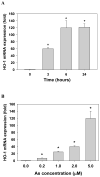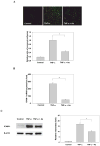Induction of heme oxygenase 1 by arsenite inhibits cytokine-induced monocyte adhesion to human endothelial cells
- PMID: 19371606
- PMCID: PMC3619387
- DOI: 10.1016/j.taap.2009.01.023
Induction of heme oxygenase 1 by arsenite inhibits cytokine-induced monocyte adhesion to human endothelial cells
Abstract
Heme oxygenase-1 (HO-1) is an oxidative stress responsive gene upregulated by various physiological and exogenous stimuli. Arsenite, as an oxidative stressor, is a potent inducer of HO-1 in human and rodent cells. In this study, we investigated the mechanistic role of arsenite-induced HO-1 in modulating tumor necrosis factor alpha (TNF-alpha) induced monocyte adhesion to human umbilical vein endothelial cells (HUVEC). Arsenite pretreatment, which upregulated HO-1 in a time- and concentration-dependent manner, inhibited TNF-alpha-induced monocyte adhesion to HUVEC and intercellular adhesion molecule 1 protein expression by 50% and 40%, respectively. Importantly, knockdown of HO-1 by small interfering RNA abolished the arsenite-induced inhibitory effects. These results indicate that induction of HO-1 by arsenite inhibits the cytokine-induced monocyte adhesion to HUVEC by suppressing adhesion molecule expression. These findings established an important mechanistic link between the functional monocyte adhesion properties of HUVEC and the induction of HO-1 by arsenite.
Figures



Similar articles
-
Far infrared therapy inhibits vascular endothelial inflammation via the induction of heme oxygenase-1.Arterioscler Thromb Vasc Biol. 2008 Apr;28(4):739-45. doi: 10.1161/ATVBAHA.107.160085. Epub 2008 Jan 17. Arterioscler Thromb Vasc Biol. 2008. PMID: 18202320 Free PMC article. Clinical Trial.
-
2,3-Dimethoxy-2'-hydroxychalcone ameliorates TNF-α-induced ICAM-1 expression and subsequent monocyte adhesiveness via NF-kappaB inhibition and HO-1 induction in HaCaT cells.BMB Rep. 2016 Jan;49(1):57-62. doi: 10.5483/BMBRep.2016.49.1.141. BMB Rep. 2016. PMID: 26277982 Free PMC article.
-
An endothelial cell adhesion protein for monocytes recognized by monoclonal antibody IG9. Expression in vivo in inflamed human vessels and atherosclerotic human and Watanabe rabbit vessels.Lab Invest. 1994 Jun;70(6):836-49. Lab Invest. 1994. PMID: 8015288
-
Oxidative stress mediates sodium arsenite-induced expression of heme oxygenase-1, monocyte chemoattractant protein-1, and interleukin-6 in vascular smooth muscle cells.Toxicol Sci. 2005 May;85(1):541-50. doi: 10.1093/toxsci/kfi101. Epub 2005 Feb 2. Toxicol Sci. 2005. PMID: 15689417
-
Induction of heme oxygenase 1 and inhibition of tumor necrosis factor alpha-induced intercellular adhesion molecule expression by andrographolide in EA.hy926 cells.J Agric Food Chem. 2010 Jul 14;58(13):7641-8. doi: 10.1021/jf101353c. J Agric Food Chem. 2010. PMID: 20536138
Cited by
-
Metabolic Derangement by Arsenic: a Review of the Mechanisms.Biol Trace Elem Res. 2024 May;202(5):1972-1982. doi: 10.1007/s12011-023-03828-4. Epub 2023 Sep 6. Biol Trace Elem Res. 2024. PMID: 37670201 Review.
-
Heme oxygenase in the regulation of vascular biology: from molecular mechanisms to therapeutic opportunities.Antioxid Redox Signal. 2011 Jan 1;14(1):137-67. doi: 10.1089/ars.2010.3153. Epub 2010 Oct 26. Antioxid Redox Signal. 2011. PMID: 20624029 Free PMC article. Review.
References
-
- Balakumar P, Kaur T, Singh M. Potential target sites to modulate vascular endothelial dysfunction: Current perspectives and future directions. Toxicology. 2008;245:49–64. - PubMed
-
- Benbrahim-Tallaa L, Waterland RA, Styblo M, Achanzar WE, Webber MM, Waalkes MP. Molecular events associated with arsenic-induced malignant transformation of human prostatic epithelial cells: aberrant genomic DNA methylation and K-ras oncogene activation. Toxicol Appl Pharmacol. 2005;206:288–298. - PubMed
Publication types
MeSH terms
Substances
Grants and funding
LinkOut - more resources
Full Text Sources

